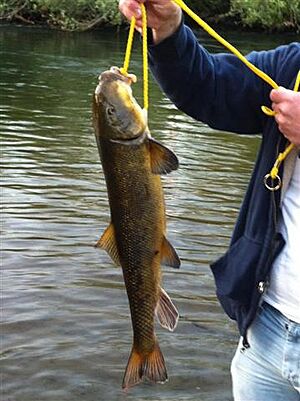Largescale sucker facts for kids
Quick facts for kids Largescale sucker |
|
|---|---|
 |
|
| Conservation status | |
| Scientific classification |
The largescale sucker (Catostomus macrocheilus) is a type of freshwater fish found in rivers and lakes across western North America. It's known for its unique mouth and large scales.
Contents
What Does the Largescale Sucker Look Like?
This fish has a rounded snout and a mouth that points downwards. This is different from most fish, whose mouths are at the very front of their heads. The largescale sucker also has big scales. Its tail connects to its body with a narrow base.
Young largescale suckers are usually less than 4 in (10 cm) long. Adult fish can grow much larger. They can reach up to 24 in (61 cm) in length and weigh around 7 lb (3.2 kg).
Young fish are often mottled brown or olive green. They have dark spots and a white or yellow belly. Adult fish are usually bronze to orange on top. Their undersides are lighter in color.
Where Does the Largescale Sucker Live?
The largescale sucker is native to the Pacific Northwest region. You can find it from British Columbia in Canada down to Oregon in the United States. It is very common in the Columbia River system.
These fish prefer the slower-moving parts of rivers and streams. They also live in lakes.
Life Cycle and Diet
Largescale suckers reproduce in the spring. They lay their eggs in shallow water over sandy areas of streams. They also use sandy or small gravel shoals in lakes. A female fish can lay up to 20,000 sticky eggs.
When they are very young, the fish eat tiny water creatures called zooplankton. As they grow, they become bottom dwellers. They then feed on small creatures that live on the bottom, like benthic aquatic invertebrates. They also eat tiny plants called diatoms and other plant material.
Largescale suckers are an important part of the food chain. Many animals that eat fish rely on them for food. These animals include osprey, eagles, river otters, and other fish.
Largescale Suckers and People
Sometimes, fish like the largescale sucker are misunderstood. Some people used to think they had a bad effect on other fish, like salmon and trout. However, scientists now know that suckers are an important part of a healthy river system. They play a vital role in the food web.
Fishing records exist for largescale suckers. The world record for catching one with all tackle is 3 lb 11 oz (1.7 kg). This fish was caught in Kalispell, Montana. The Idaho state record is a larger fish, weighing 9 lb (4.1 kg). A fish measuring 27.7 in (70 cm) holds the record for catch and release.



